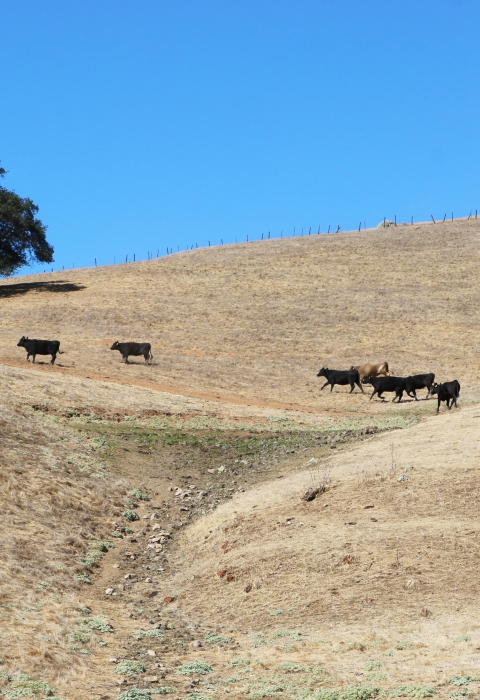Amidst the rolling grasslands and oak woodlands of Santa Clara and San Benito counties lies Sparling Ranch, just outside the small town of Hollister, California. On warm summer days, herds of cattle graze and rest on the sloping hillsides.
During nighttime winter rains, small, brightly-colored amphibians called California tiger salamanders leave the protection of ground squirrel burrows to make the trek to stock-ponds that dot the landscape. There, they breed with their mates and keep company with another rare amphibian, the California red-legged frog. As their names suggest, both species are endemic to California, and both are protected under the Endangered Species Act (ESA).
At Sparling Ranch, cattle, salamanders, and frogs peacefully coexist, and will continue to for years to come. Cattle ranching and healthy habitat for these native, rare amphibians prove to go hand in hand, explains U.S. Fish and Wildlife Service (Service) biologist Jeff Phillips.
“California tiger salamanders historically used naturally occurring ponds in valley bottoms to breed. But those valley bottoms also became attractive to people, and over time, many of the ponds were drained permanently and bulldozed over to make way for houses or farms,” Phillips explains. “Ranching in the foothills, however, provided large, contiguous open spaces, including grassland and chaparral habitat ideal for salamanders. The stock ponds that were built by ranchers became suitable breeding grounds for the salamanders and frogs that were pushed out of the valleys.”
Now, through the establishment of the Sparling Ranch Conservation Bank, more than 2,000 acres of valuable habitat will be permanently protected for California tiger salamanders and California red-legged frogs, including 14 breeding ponds, while the Sparling family continues to raise and graze cattle on their land.
Tom and Ed Sparling are cousins and reminisce about the history amidst these hills, where their families have ranched, hunted, and fished for six generations. Their great-great grandfather was the infamous T.S. Hawkins, who traveled hundreds of miles by wagon from Missouri to California and originally settled the land at the turn of the century.
“It’s been a good thing,” Tom says of establishment of the bank. “We’re keeping the property in the family. By treading lightly on the land, not overgrazing, and developing water, we were already managing the land in a way that was good for these species.”
The ranch has been used for cattle ranching for more than a century. “It’s been my livelihood. I’ve lived here since I was three months old,” Ed says. Ed, his son, and other cattlemen who lease land on the property will continue their ranching operations following establishment of the bank.
A herd of cattle kicks up dust underneath a beautiful old bay tree as Tom parks his truck a few hundred yards from McClure pond. Ed’s sister was married under that beautiful bay tree. According to biologists, McClure pond is one of the most productive California red-legged frog ponds in the area.
In exchange for permanently protecting the land and managing it for these species, the Service and California Department of Fish and Wildlife approve a specified number of species credits that the conservation bank may sell to project developers in surrounding areas to mitigate project impacts on federally protected species, like the California tiger salamander, as required under the ESA.
Sparling Ranch sits just outside of Hollister, 50 miles south of the bustling Silicon Valley. For developers in the Hollister area and beyond, the Sparling Ranch Conservation Bank provides a simple, economical opportunity to save both time and money while ensuring their project doesn’t negatively impact a species’ chance at recovering. Developers with projects in designated service areas stretching from Alameda County southward to Kern County may be authorized to purchase credits in the bank.
Michael Anderson is a property developer and established South Bay Conservation Resources to work with landowners and state and federal officials to identify high quality habitat for rare wildlife that could be preserved as part of regulatory compliance for property development. Anderson’s team is developing Santana Ranch, a master planned community in Hollister with a variety of homes, parks, and a school site, and will be the first to purchase credits in the conservation bank.
“We saw there would be an increasing need for conserving California tiger salamander and California red-legged frog habitat, so we searched for properties with high-quality habitat until we found Sparling Ranch,” Anderson says.
Phillips coordinates the Service’s Conservation Banking program along the central California coast and says that conservation banks can achieve strategic conservation over a large area of the landscape. Land conservation opportunities can be sought out in the most valuable habitat for recovering the species and conserved by selling credits to offset impacts to less important habitat by development projects elsewhere in the species’ range.“If you’re a housing developer, you don’t typically specialize in biology or ecological restoration,” Phillips says. “Developers that I’ve worked with have appreciated conservation banks as a mitigation option, because they can simply purchase credits and know their project is in compliance with the ESA, and get back to their work,” he explains.
Tom recalls the fateful day biologists surveying the property discovered California tiger salamanders in 2011. At that time the family was considering selling the property. “They scooped ‘em up and couldn’t believe it. But it makes sense. We have cattle, we have squirrels, and we have vernal pools. It’s the magic three.”
Other native species that may use the area include burrowing owls, golden eagles, Western spadefoot toad, and Western pond turtle.
Tom abruptly pumps the breaks of his truck and peers out the window to the sky overhead. “Look there, a golden eagle.” The eagle flies low over the grasslands before ascending out of eyesight into the blazing sun. “That’s the thing about this place. You always see something new. It’s always changing.”
David Hacker, a conservation and mitigation banking coordinator with CDFW says the number of species that will benefit is too long to list, “Banks like this benefit the whole wildlife community, not just the species for which credits will be sold.”
Tom slows the truck as a doe and her two young buck cross the road in front of us. “We’re sportsmen, hunters and fisherman. So are our kids. Six generations,” he says. “Ed looks at it from a cattlemen’s perspective, I look at it from a hunting and fishing standpoint. In the end we all came together,” he said.
In some cases, landowners face financial pressure to sell or develop their land because of the expense of maintaining open space. But for landowners who want to maintain their undeveloped land the way it is, conservation banks can be a financially attractive option. The presence of endangered species on a property is a good indication that the landowner has been an excellent steward of their land. In many cases a landowner can continue to do what they have always done with the land while generating additional income.
Of the 167 conservation banks that have been established nationwide, 109 are in the golden state. While Phillips says the majority of existing conservation banks are in the Central Valley and northern and southern California, he is hopeful that the growing trend will make its way to California’s central coast.
“It’s exciting to see an increase in the number of conservation banks throughout the state. It’s a sign that the Service is achieving the win-win we always strive for—a win for wildlife and a win for landowners and developers who partner with us to ensure conservation and development occur together,” said Jennifer Norris, Ph.D., field supervisor of the Sacramento Fish and Wildlife Office, who has supported the establishment of banks throughout portions of the Central Valley.
“What’s great about conservation banks is that everyone walks away from the process better off,” Phillips says. “You have permanently protected habitat for rare wildlife, landowners continue their activities on the land and generate additional income, and project developers complete and certify their mitigation in advance. Everybody wins.”
The Sparling Conservation Bank is considering adding another 1,282 acres containing seven more ponds in the future.











